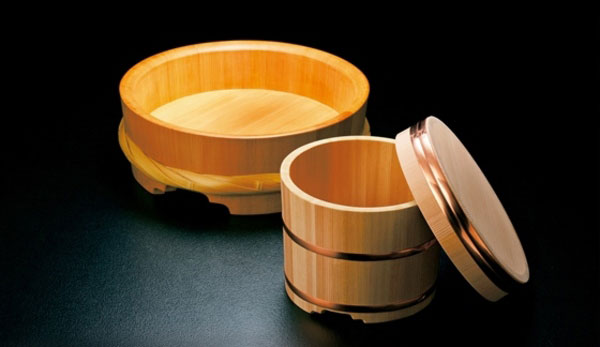 Photo:Akita Prefecture
Photo:Akita Prefecture
- Wood, bamboo crafts
- Akita
Akita cedar tubs and barrels Akita sugi oke taru
First-class techniques that reveal
the warmth and beauty of the wood grain
Description
What is Akita cedar tubs and barrels ?
Akita-sugi Oke Taru are handmade Akita cedar tubs and barrels produced from locally grown cedar timber in the cities of Odate and Noshiro of Akita Prefecture since around the late Heian period (11th century). Products made of straight grain wood with no lid and a bamboo or copper hoop are called oke (tubs) and lidded products made of flat grain wood are classified as taru (barrels). The beautiful grains are characteristic of these tubs and barrels, which are still made in the time-honored way using the skills passed down through the generations. However, they are not just pleasing to the eye, but have superb water absorbency, and the distinctive pleasant cedar fragrance is said to enhance the taste of sake rice wine. They are also very resistant to dampness and scarcely shrink while in use, which helps to avoid the products from warping. Another much appreciated advantage is that the wood adjusts the concentration of salt, making them ideal for pickling vegetables.
History
The history of Akita-sugi Oke Taru is very old. Fragments of tubs made in the late Heian period (794 - 1185) that were found in the ruins of Akita Castle are considered to be the oldest that remain today. During the Edo period (1603 - 1868), the feudal lord of Akita encouraged the production of tubs and barrels. This became an industry and production of tubs and barrels increased. According to the "Umezu Masakage Nikki" (The Diary of Masakage UMEZU) written by the chief retainer of the Akita domain, sake barrels made of Akita cedar were being used in the castle towns in 1612. The Akita cedar tubs and barrels have been used regularly by common people since the Edo period, and the form of the products have not changed up to this day. From the Meiji period (1868 - 1912) through the Taisho period (1912 - 1926), demands for tubs and barrels increased, and the sturdy Akita cedar tubs and barrels were popular among the people. In those days, they were used in various ways such as wash tubs, containers for cooked rice, and soy sauce barrels, but they gradually went out of use after plastic products emerged in the 1960s. Recently, the warmth of wood and the high quality of the Akita cedar products are gaining attention again.
General Production Process
- 1. Preparing the timber First, from the center of a cedar log, fan-shaped blocks are cut out to fit the product circumference and depth. The blocks are then further split with a hatchet to make small panels called kure, which are then naturally dried for about 90 to 100 days, followed by a further 30 days or so of artificial drying. According to the purpose of the final product, straight grain panels called masame-gure or flat grain panels called itame-gure are prepared.
- 2. Shaving
Using a two-handed special blade called sen, the artisan sits astride a workbench called uma and shaves the prepared kure to the desired size.
- 3. Planing
A large plane called shojiki is used to align the joints of the kure. To complete one tub, 17 to 18 pieces of kure are needed. After further planing, a ruler-like tool called kegata is used to mark out the sizes and angles of the kure, and further planing is done to reduce the kure to the precise dimensions and shapes.
- 4. Assembling
The wooden panels, kure, are secured with bamboo pegs and gradually the tub shape is formed. The grain and color of the kure adjoined are matched, so that the tubs are both perfectly fitted and pleasing to the eye. A temporary hoop is wrapped around the circumference to prevent any loss of shape to the perfect tub circle.
- 5. Plane finish
To finish the surface, convex and concave planes with round blades are used to plane the inside and outside of the tub. When planing the inside with a convex plane, the artisan rotates the tub with their feet. A groove to fit the base plate is cut on the inside at this stage with a tool called kehiki.
- 6. Fitting the hoop and bottom plate
After finally fitting the bottom plate and a permanent bamboo hoop, the artisan turns the tub using their hands and feet and tightens the hoop with a mallet. Japanese timber bamboo is the best material for hoops and they need careful shaving to ensure a smooth surface. Finally, the kure are worked and tightened from the outside to complete.
Where to Buy & More Information
Shinrin Shiryokan Gomokujo

-
Address
-
Tel.+81-18-852-3110
-
ClosedDecember 1 to March 31
-
Website
See more Wood, bamboo crafts
- Hakone wood mosaic
- Iwayado traditional chest
- Kaba cherrybark woodcrafts
- Odate bentwood
- Inami wood carvings
- Matsumoto furniture
- Beppu bamboo crafts
- Edo wood joinery
- Ichii woodcarvings
- Suruga bamboo crafts
- Edo bamboo fishing rods
- Kishu bamboo fishing rods
- Kamo traditional chest
- Kyo wood joinery
- Miyakonojo archery bows
- Osaka carved wooden panel
- Miyajima woodwork
- Nibutani carved wooden tray
- Okuaizu Basketry
- Echizen traditional chest
- Kasukabe traditional paulownia chest
- Katsuyama bamboo crafts
- Osaka karaki wood joinery
- Takayama tea whisks
- Toyooka wicker crafts
- Akita cedar tubs and barrels
- Nagiso woodturning
- Kishu traditional chest
- Nagoya traditional paulownia chest
- Osaka bamboo screens
- Osaka-senshu traditional paulownia chest
- Sendai traditional chest































































































































































































































































































